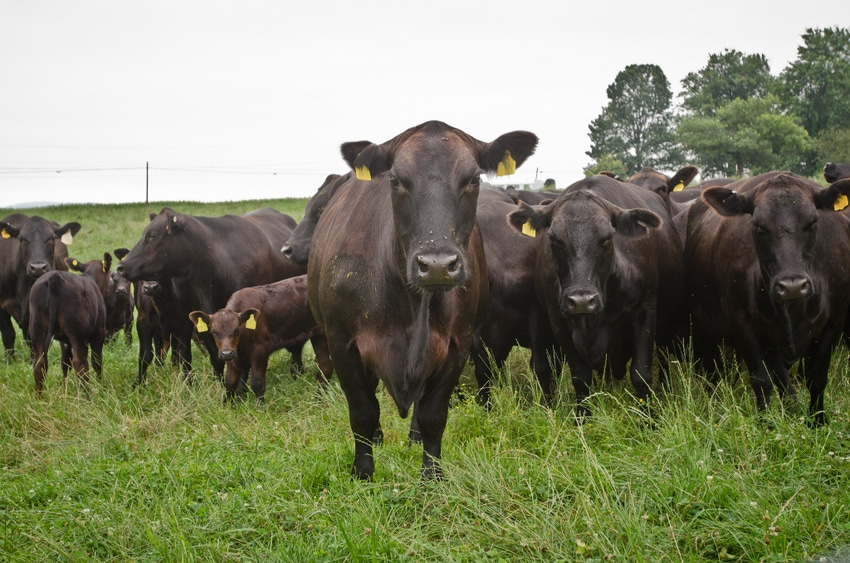LIVESTOCK MARKETS: Cow herd expansion to keep market prices lower
Export opportunities could help move abundant protein supply.

The cattle inventory across the U.S. will continue to expand, and that will likely keep prices in moderation through 2017, according to Texas A&M AgriLife Extension Service economist Dr. Jason Johnson.
Johnson, extension economist in Stephenville, Texas, discussed cattle market trends during the recent Blackland Income Growth Conference in Waco, Texas.
“There's more cattle and cheaper prices,” Johnson said, adding that cattle prices began a rapid downward spiral leading into the fall.
“It seems like we fell off a cliff fast,” he said. “We started building back the cow herd at about a 3% clip, and then prices fell nearly 40% this year.”
Johnson said during 2015, when cattle prices hit historic highs, feedlot operators were bidding up feeder cattle to keep pens full and operations going. Feedlots operate much like hotels, attempting to keep occupancy rates high.
“When they closed the books on those pens of cattle, they were losing $300-400 a head,” he said.
As such, feedlot operators started getting more judicious on what they paid for feeder cattle in 2016. “Overall, I think the bubble has been burst. We are now back down to more historic spread levels," Johnson said. "I don't think we will see another drop quite so dramatic as inventory and price expectations have returned to levels that should permit some participants at all levels of the supply chain to be profitable.”
Johnson said there will be buildups in cattle inventory over the next two to three years.
“That doesn't mean that prices will continue to decline,” he noted. “That dislocation of what feedlots were losing has gone away.”
Feedlot placements for 2016 have been on the increase, Johnson said.
“You've got a pen of calves ready to market. Do you take them to sell right now? I can tell you a lot of folks are holding back a little bit, but that can't go on forever," he said. "There could be some spillage in the first quarter of 2017, and we could see some (more) downward prices.”
Production of other protein meats such as broilers and pork also has increased.
“Broiler production is at all-time highs. There's a lot of protein on the market right now — as much as there has ever been. We also have a lot of beef,” he said.
Johnson noted that some export trade opportunities will help market the excess beef. Japan, Canada, Mexico and South Korea are the U.S.'s current top export markets. With a new presidential administration, there could be further trade opportunities for beef.
Texas AgriLife Extension livestock economists project that steer prices for 500-600 lb. feeders in 2017 will be $127-132/cwt. in the first quarter, $131-138/cwt. in the second quarter, $127-132/cwt. in the third quarter and $122-132/cwt. in the fourth quarter.
“We're seeing slow and steady work down as prices slide,” Johnson said. “That's attributed to the inventory build we expect to continue to see in 2017 and beyond. With lower prices, the impetus will be on the cow/calf producer to continue exploring ways to become more efficient in their operations.”
Market recap
The December fed cattle future market rallied this week after a long holiday weekend. Nearby contracts closed higher Tuesday at $114.95/cwt. and posted gains through Thursday's close of $118.70/cwt.
January feeder cattle futures were mostly higher as well. Nearby contracts closed lower Tuesday at $129.95/cwt. but finished higher Thursday at $131.925/cwt.
For the beef cutouts this week, Choice and Select were higher at $203.47/cwt. and $193.89/cwt., respectively.
December lean hog futures were mixed. Nearby contracts closed higher Monday at $64.75/cwt. but closed lower Thursday at $64.65/cwt.
Pork cutout values were lower this week. The wholesale pork cutout was lower at $81.08/cwt. Loins and hams were lower at $77.85/cwt. and $72.05/cwt., respectively. Bellies were also lower at $114.84/cwt.
Hogs delivered to the western Corn Belt were lower this week, closing at $51.77/cwt. on Thursday.
The U.S. Department of Agriculture reported the Eastern Region whole broiler/fryer weighted average price at 82.91 cents/lb. on Dec. 23.
According to USDA, egg prices have been steady, with a lower to mostly lower undertone. Offerings have been light in the Southeast and moderate to heavy elsewhere. Supplies and demand both have been light to moderate.
Large eggs delivered to the Northeast were unchanged at $1.26-1.30/doz. Prices in the Southeast and Midwest were higher at $1.41-1.44 cents/doz. and $1.30-1.33/doz., respectively. Large eggs delivered to California were unchanged at $1.83/doz.
For turkeys, USDA said the market was steady to weak, with light to moderate offerings. Demand has been light. Prices were lower, at $1.00-1.04/lb. for hens and $1.00-1.05/lb. for toms.
About the Author(s)
You May Also Like



